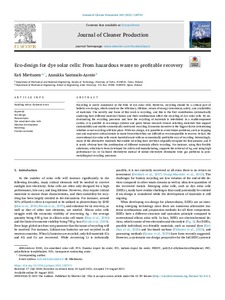Eco-design for dye solar cells: From hazardous waste to profitable recovery
Miettunen Kari; Santasalo-Aarnio Annukka
https://urn.fi/URN:NBN:fi-fe2021102752609
Tiivistelmä
Recycling is rarely considered in the field of dye solar cells. However, recycling should be a critical part of holistic eco-design, which considers the efficiency, lifetime, return of energy investment, safety, and availability of materials. The novelty and focus of this work is recycling, and this is the first contribution systematically analyzing how different material choices and their combinations affect the recycling of dye solar cells. By understanding the recycling processes and how the recycling of materials is interlinked in a multicomponent system, it is possible to eco-design systems and guide future research toward selecting materials that support sustainability and enable economically motivated recycling. Economic incentive is the biggest factor determining whether or not recycling will take place. With eco-design, it is possible to avoid future problems, such as trapping rare and expensive critical metals in waste from which they are difficult or even impossible to recover. In fact, the conventional dye solar cells create harmful waste with no economically profitable way of recycling. Interestingly, many of the alternative materials that enable recycling have not been originally designed for that purpose, and it is rarely obvious how the combination of different materials affects recycling. For instance, using thin flexible substrates, which have been developed for roll-to-roll manufacturing, supports the retrieval of Ag, and using high performance Co- or Cu-based electrolytes instead of iodine electrolyte eliminates toxic gas problems in pyrometallurgical recycling processes.
Kokoelmat
- Rinnakkaistallenteet [27094]
